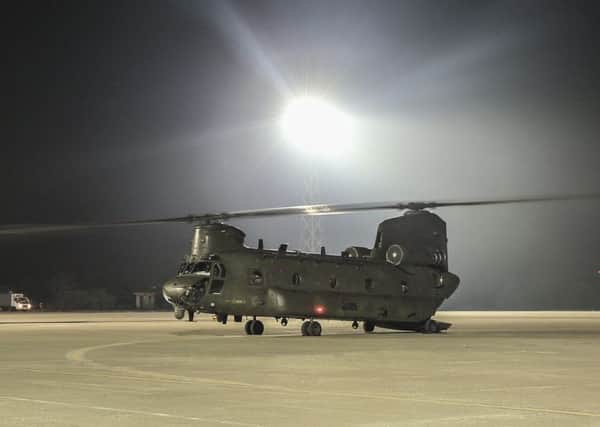UK Mission to rescue Yazidi refugees ruled out


British planes will continue to drop aid to the remaining Yazidis on Mount Sinjar, but the US mission found there were only a few thousand remaining on the mountainside and they were in better condition than had been feared.
Prime Minister David Cameron said yesterday that it was “good news” but said the UK had armed forces assets in place to “help out in the right way” if the situation demanded it.
Advertisement
Hide AdAdvertisement
Hide AdHe confirmed that an RAF Tornado jet equipped with sophisticated surveillance equipment had flown over the area, while further aid drops had also taken place.
Chinook helicopters, which could be used to transport personnel or pick up refugees stranded on the mountain by the onslaught of Islamic State (IS) forces, had also arrived at a base in Cyprus.
Speaking at the UK disaster response operations centre at Cotswold Airport in Kemble, Gloucestershire, he said: “There does seem to be some good news and that is the American-led scouting operation has found fewer people on the mountainside than expected.
“Also, we see that the UK aid drops have made a difference and have got through to people. It’s good news that there are fewer people there and they are in better condition than expected.”
Last night, two US unnamed officials confirmed there were about 4,500 people on Mount Sinjar. Nearly half are herders who lived there before the siege and have no interest in being evacuated, the officials said.
US defence secretary Chuck Hagel said the information made it “far less likely” that a rescue mission would be needed. Yesterday, International Development Secretary Justine Greening said a combination of US air strikes and resistance from Kurdish fighters had helped create an escape route for the refugees, who fled to Sinjar.
Ms Greening, who refused to comment on reports that SAS troops were on the ground in Iraq, said an evacuation from Mount Sinjar had not been ruled out but was less likely after the US assessment.
She said: “The US has been clear overnight that although it is saying an evacuation approach is less likely, that is still an option that is on the table. The Prime Minister has been very clear that if an evacuation does take place, we will play our role in that. So that option is still there.”
Advertisement
Hide AdAdvertisement
Hide AdMr Cameron, who will chair a meeting of Whitehall’s Cobra emergency committee to discuss the crisis, said the government would “respond to the situation as it develops”.
He added: “We need to make sure we have good information about how many people there are, how many need to leave, how well they can get to a place of safety.”
Mr Cameron said it was “very difficult” to gain correct information from the ground due to the fighting taking place.
“The information is uncertain, the information, is fluid and we have to make sure we’re getting the latest information and acting on it,” he said.
The UK has agreed to transport weapons and ammunition supplied by other countries to the Kurdish Peshmerga forces but has so far refused to follow France in directly providing military equipment.
UN assessments had previously estimated that around 30,000 refugees had been trapped on Sinjar in searing heat.
An effort to step up the EU’s aid effort will be made today after Mr Cameron and French president Francois Hollande have said the EU “could do more” to provide aid to Iraq.